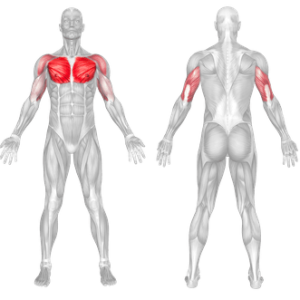Dumbbell Press Overview
The dumbbell press is a classic upper-body strengthening exercise that works your chest. Your chest muscle are the main muscles targeted by the exercise, but as an added bonus it also works your anterior deltoid and triceps. It is an alternative to the barbell bench press and offers some unique benefits due to the use of individual dumbbells.
How To do:
- Setup:
- Lie flat on a bench with your feet firmly planted on the ground.
- Hold a dumbbell in each hand, resting them on your thighs.
- Starting Position:
- Using a controlled motion, bring the dumbbells up to shoulder level while sitting on the bench. This is your starting position.
- Your palms should be facing forward, and your wrists should be in a neutral position.
- Execution:
- Inhale and engage your core muscles.
- Slowly lower the dumbbells towards your chest in a controlled manner, keeping your elbows at about a 45-degree angle to your body. Your upper arms should be parallel to the floor.
- Lower the dumbbells until your elbows are slightly below the bench level or until you feel a gentle stretch in your chest muscles.
- Pushing Phase:
- Exhale and push the dumbbells back up to the starting position, fully extending your arms without locking your elbows.
- Keep your chest engaged and maintain a slight arch in your lower back throughout the movement.
- Repeat:
- Perform the desired number of repetitions, maintaining proper form and control.
Coach Tips:
- Start with a weight that you can lift comfortably while maintaining proper form. Gradually increase the weight as you become more experienced and stronger.
- Focus on a controlled movement both during the lowering and pushing phases to maximize muscle engagement and minimize the risk of injury.
- Keep your shoulder blades retracted (pinched together) to provide stability and support to your shoulders.
Benefits of Dumbbell Press
1. Builds Strength and Mass
- The dumbbell bench press primarily targets the pectoral muscles (chest), helping to develop size and strength in the chest area. It also engages the anterior deltoids (front shoulders) and triceps, contributing to overall upper body muscle development.
2. Muscle Symmetry and Balance
- Independent movement: Dumbbells require each arm to work independently, helping address muscular imbalances and ensuring both sides develop evenly.
- Improved coordination: The movement challenges stabilizing muscles, enhancing neuromuscular control.
3. Greater Range of Motion
- Dumbbells allow a deeper stretch and contraction compared to a barbell, engaging the muscles more effectively and promoting flexibility and strength across a wider range of motion.
4. Enhanced Stabilization
- The need to balance the dumbbells engages smaller stabilizing muscles, especially in the shoulders, core, and arms, which improves joint stability and reduces injury risk.
5. Joint-Friendly Option
- The dumbbell press provides a more natural path of motion compared to a barbell, reducing stress on the shoulders and wrists, making it a safer option for many people.
6. Versatility
- Different angles: They can be performed on a flat, incline, or decline bench to target various parts of the chest and shoulders.
- Variety of movements: You can switch grips (neutral, pronated, or supinated) to activate different muscle groups.
Dumbbell Bench Press Muscles Worked


